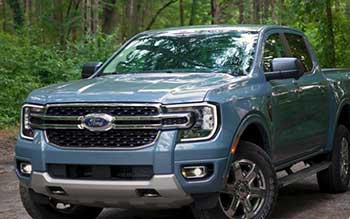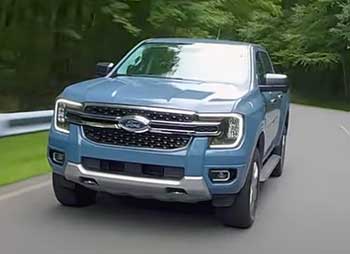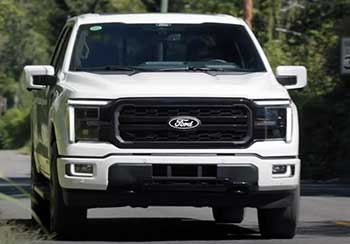
As a truck enthusiast who’s spent years behind the wheel of various pickups, I’ve always been drawn to Ford’s legendary lineup.
The Ford Ranger and Ford F-150 stand out as two of the most popular choices, each catering to different needs. In this article, I’ll share my firsthand experiences with both trucks, comparing their performance, features, and practicality to help you decide which one suits your lifestyle.
From towing heavy loads to navigating city streets, I’ll break down the pros, cons, and maintenance tips, offering a clear picture of what these trucks bring to the table.
Comparison Table
| Feature | Ford Ranger (2024) | Ford F-150 (2024) |
|---|---|---|
| Starting MSRP | $35,025 | $39,645 |
| Engine Options | 2.3L I-4 (270 hp), 2.7L V6 (315 hp), 3.0L V6 (405 hp, Raptor) | 2.7L V6 (325 hp), 5.0L V8 (400 hp), 3.5L V6 (400-450 hp), Hybrid (430 hp) |
| Towing Capacity | Up to 7,500 lbs | Up to 13,500 lbs |
| Payload Capacity | Up to 1,805 lbs | Up to 2,455 lbs |
| Fuel Economy | 21/26 mpg (city/highway, RWD) | 20/24 mpg (V6, RWD), 22/24 mpg (Hybrid) |
| Interior Space | SuperCrew: 34.5 inches rear legroom | SuperCrew: 43.6 inches rear legroom |
| Length | 210.9 inches | Up to 232.0 inches |
| Trim Levels | XL, XLT, Lariat, Raptor | XL, XLT, Lariat, King Ranch, Platinum, Raptor |
| Off-Road Package | Tremor, Raptor | FX4, Raptor |
| Tech Features | SYNC 4, 10.1-inch touchscreen, Co-Pilot360 | SYNC 4, 12-inch touchscreen, Pro Power Onboard |
My Experience With the Ford Ranger
I’ve had the chance to drive the 2024 Ford Ranger for several months, and it’s a truck that feels like a perfect middle ground for someone like me who needs versatility without overwhelming size. The Ranger’s midsize footprint makes it a breeze to maneuver through tight city streets or crowded parking lots, which I’ve appreciated during my daily commutes.
Its standard 2.3-liter EcoBoost inline-4 engine, pumping out 270 horsepower and 310 pound-feet of torque, feels peppy enough for most tasks, whether I’m hauling mulch for a weekend project or towing a small trailer for a camping trip. The 10-speed automatic transmission shifts smoothly, keeping the engine in its sweet spot.
The interior of the Ranger surprised me with its modern touches. The SuperCrew cab offers decent space for four adults, though taller passengers in the back might feel a bit cramped with 34.5 inches of legroom. The 10.1-inch touchscreen with SYNC 4 is intuitive, and I found myself relying on the wireless Apple CarPlay for navigation and music.
The Ranger’s off-road trims, like the Tremor and Raptor, are a blast on rough trails. I took a Raptor model through a muddy off-road course, and its 405-horsepower 3.0-liter V6, paired with Fox shocks and all-terrain tires, handled every obstacle with confidence.
However, the Ranger isn’t perfect. Its payload capacity maxes out at 1,805 pounds, which is solid for a midsize truck but can’t compete with larger pickups for heavy-duty jobs. I also noticed that while the fuel economy (21/26 mpg city/highway in RWD) is respectable, it’s not significantly better than some full-size trucks, which was a bit disappointing. Overall, the Ranger feels like a truck built for those who want capability without the bulk, but it’s not without compromises.
My Experience With the Ford F-150
The 2024 Ford F-150 is a beast of a different breed. I’ve driven this full-size pickup for work and play, and it’s clear why it’s been America’s best-selling truck for decades. Its size is immediately noticeable—up to 232 inches long, it dwarfs the Ranger. This makes it less ideal for tight urban environments, but the extra space translates to unmatched versatility.
The F-150’s engine lineup is a major highlight, offering everything from a 2.7-liter V6 (325 hp) to a monstrous 5.2-liter V8 in the Raptor R (700 hp). I tested the 3.5-liter PowerBoost hybrid, which delivers 430 horsepower and a smooth, efficient ride at 22/24 mpg.
The F-150’s interior is a step above the Ranger in terms of luxury and space. The SuperCrew cab offers 43.6 inches of rear legroom, making it feel like a living room on wheels. I’ve hauled my family and their gear for weekend trips, and everyone had plenty of room to stretch out. The available 12-inch touchscreen and features like Pro Power Onboard (a mobile generator) make the F-150 a mobile command center. On one job site, I used it to power tools, which was a game-changer.
Towing with the F-150 is where it truly shines. With a max capacity of 13,500 pounds, I’ve towed heavy trailers with ease, something the Ranger can’t match. The Pro Trailer Backup Assist made maneuvering a breeze, even in tight spaces.
However, the F-150’s size and higher price tag (starting at $39,645) make it overkill for those who don’t need its full capability. It’s a truck for those who demand the best in power and space, but it comes at a cost.
Pros Of the Ford Ranger

- Affordable Price Point: Starting at $35,025, the Ranger is significantly cheaper than the F-150, making it accessible for budget-conscious buyers who still want a capable truck.
- Maneuverability: Its compact size (210.9 inches long) makes it easier to navigate urban environments and park in tight spaces compared to the bulkier F-150.
- Fuel Efficiency: The standard 2.3-liter engine achieves 21/26 mpg (city/highway, RWD), slightly better than the F-150’s base V6, which is great for daily driving.
- Off-Road Capability: The Tremor and Raptor trims offer excellent off-road performance with features like Fox shocks, skid plates, and all-terrain tires, perfect for adventure seekers.
- Modern Tech: The SYNC 4 system with a 10.1-inch touchscreen and Co-Pilot360 driver aids (like blind-spot monitoring) provide a tech-forward experience.
- Versatile Engine Options: With the 2.7-liter V6 (315 hp) and 3.0-liter V6 (405 hp, Raptor), the Ranger offers a good balance of power and efficiency for its class.
The Ranger’s affordability and nimbleness make it a fantastic choice for someone like me who splits time between city driving and weekend adventures. I’ve found its tech suite surprisingly robust for a midsize truck, and the off-road trims rival more expensive models in capability. The fuel economy, while not groundbreaking, helps keep costs down for daily use. For those who don’t need to tow massive loads or haul heavy equipment, the Ranger’s specs are more than sufficient, offering a practical blend of power and efficiency. It’s a truck that feels approachable yet capable, which is why I often recommend it to friends looking for a versatile daily driver.
Also read: My Thoughts on Ford Edge Vs. Hyundai Tucson.
Cons Of the Ford Ranger
- Limited Towing Capacity: With a max towing capacity of 7,500 pounds, it falls short for heavy-duty tasks compared to the F-150’s 13,500 pounds.
- Cramped Rear Seating: The SuperCrew’s 34.5 inches of rear legroom feels tight for taller passengers, especially on long trips.
- Payload Constraints: The maximum payload of 1,805 pounds is decent but limiting for those needing to haul heavy materials regularly.
- Fuel Economy Not Exceptional: While better than the F-150’s base engine, the Ranger’s 21/26 mpg isn’t a significant leap over full-size trucks.
- Fewer Trim Options: With only four trims (XL, XLT, Lariat, Raptor), it lacks the customization variety of the F-150’s eight trims.
- Less Luxurious Interior: Despite nice touches like leather in the Lariat, the Ranger’s cabin feels less premium than the F-150’s higher trims.
The Ranger’s limitations became apparent when I needed to tow a larger trailer or carry a full load of construction materials. The rear seating was a frequent complaint from my taller friends during group trips, and I wished for more trim options to tailor the truck to my needs. The fuel economy, while decent, didn’t blow me away, especially when compared to some hybrid options in the full-size segment. For those who prioritize heavy-duty capability or luxury, the Ranger can feel like it’s playing catch-up to its bigger sibling.
Maintenance Tips For the Ford Ranger
- Regular Oil Changes: Change the oil every 7,500 miles or six months to keep the EcoBoost engines running smoothly, as turbocharged engines are sensitive to oil quality.
- Tire Rotations: Rotate tires every 6,000-8,000 miles to ensure even wear, especially if you use the Ranger for off-roading or towing.
- Check Transmission Fluid: The 10-speed automatic requires fluid checks every 30,000 miles to maintain smooth shifting and prevent wear.
- Inspect Brake Pads: Check brake pads every 20,000 miles, as the Ranger’s stopping power can wear down faster under heavy loads or off-road conditions.
- Clean Air Filters: Replace cabin and engine air filters every 15,000 miles to optimize performance and fuel efficiency, especially in dusty environments.
- Monitor Suspension: For off-road trims like the Tremor or Raptor, inspect shocks and bushings every 25,000 miles to ensure they handle rough terrain effectively.
- Battery Maintenance: Test the battery annually, as the Ranger’s tech-heavy features can strain it, particularly in extreme weather.
Maintaining my Ranger has been straightforward, but staying on top of these tasks is key to its longevity. I learned the hard way that neglecting air filters in dusty conditions can sap performance, and regular tire rotations saved me from uneven wear during off-road trips. The EcoBoost engines are reliable but demand quality oil to avoid turbo issues. By keeping up with these maintenance steps, I’ve kept my Ranger running like new, even after tackling tough trails and hauling moderate loads.
Pros Of the Ford F-150

- Superior Towing Capacity: With up to 13,500 pounds of towing capacity, it’s ideal for heavy trailers, boats, or equipment, outclassing the Ranger.
- Spacious Interior: The SuperCrew’s 43.6 inches of rear legroom and 9.7 inches more shoulder room make it perfect for families or long trips.
- Diverse Engine Lineup: From the 2.7-liter V6 to the 5.2-liter V8 and hybrid options, the F-150 offers unmatched power flexibility.
- Advanced Technology: Features like Pro Power Onboard, a 12-inch touchscreen, and Pro Trailer Backup Assist elevate its functionality.
- Higher Payload: Up to 2,455 pounds of payload capacity makes it a workhorse for heavy materials or job-site needs.
- Luxury Options: Higher trims like Platinum offer leather Recaro seats and premium finishes, rivaling luxury SUVs in comfort.
- Customization Variety: Eight trim levels and multiple cab/bed configurations allow for tailored builds to suit any need.
The F-150’s sheer capability blew me away when I needed to tow a 10,000-pound trailer for a construction project. The interior feels like a luxury vehicle in higher trims, and the tech features, like Pro Power Onboard, made my job sites more efficient. The range of engines means there’s something for everyone, whether you’re after efficiency or raw power. For those who need a truck that can do it all, the F-150 delivers in spades, making it my go-to for big tasks.
Cons Of the Ford F-150
- Higher Price Tag: Starting at $39,645, it’s pricier than the Ranger, with top trims like the Raptor R exceeding $100,000.
- Poor Maneuverability: Its size (up to 232 inches long) makes parking and city driving more challenging than with the Ranger.
- Lower Fuel Economy: The base V6 gets 20/24 mpg, and V8 options are less efficient, increasing long-term fuel costs.
- Complex Maintenance: With more engine options and advanced tech, repairs can be costlier and more complex than the Ranger.
- Overkill for Light Tasks: For casual use or small loads, the F-150’s size and power feel excessive compared to midsize trucks.
- Larger Turning Radius: The F-150’s wider turning radius makes tight maneuvers trickier, especially in urban settings.
The F-150’s size was a hassle when I tried to park in downtown areas, and the higher fuel costs added up during daily commutes. The maintenance, especially for the hybrid or high-output engines, requires more expertise and expense than the Ranger. For someone who doesn’t need its full capability, the F-150 can feel like too much truck, both in terms of cost and handling.
Read more: My Thoughts on GMC Terrain Vs. Ford Escape.
Maintenance Tips For the Ford F-150
- Oil and Filter Changes: Change oil every 7,500 miles for gas engines and 5,000 miles for hybrids to maintain engine health.
- Tire Maintenance: Rotate tires every 6,000 miles and check alignment, as the F-150’s weight can cause uneven wear.
- Transmission Checks: Inspect the 10-speed transmission fluid every 30,000 miles to ensure smooth operation under heavy loads.
- Brake System Care: Replace brake pads every 25,000 miles, especially if towing, to maintain stopping power.
- Cooling System: Flush the coolant every 100,000 miles to prevent overheating, particularly in V8 or hybrid models.
- Battery Checks: Test the battery every year, as features like Pro Power Onboard can drain it faster.
- Suspension Inspection: Check shocks and struts every 30,000 miles, especially for off-road trims like the Raptor or FX4.
Keeping my F-150 in top shape requires diligence, but it’s worth it for its performance. I’ve found that regular tire rotations are crucial given its weight, and the hybrid model’s battery needs extra attention due to its tech demands. The cooling system is a big deal for heavy towing, and I’ve avoided issues by staying on top of fluid changes. These steps have kept my F-150 reliable, whether I’m on a job site or a cross-country trip.
Comparison With Other Brands
- Ford Ranger vs. Chevrolet Colorado: The Ranger’s 7,500-pound towing capacity matches the Colorado’s, but its 2.3-liter engine feels smoother than the Colorado’s base 2.7-liter turbo. However, the Colorado offers a slightly higher payload (1,900 lbs) and a more refined ride in higher trims.
- Ford Ranger vs. Toyota Tacoma: The Tacoma’s reliability is legendary, but its base 2.4-liter engine (278 hp) lacks the Ranger’s refinement. The Ranger’s tech, like SYNC 4, outshines the Tacoma’s dated infotainment, though the Tacoma’s resale value is stronger.
- Ford F-150 vs. Chevrolet Silverado 1500: The Silverado’s 6,200-pound payload capacity beats the F-150’s, but the F-150’s hybrid option and Pro Power Onboard give it an edge in versatility. The Silverado’s interior feels less premium in lower trims.
- Ford F-150 vs. Ram 1500: The Ram 1500’s air suspension offers a smoother ride than the F-150’s, but the F-150’s towing capacity (13,500 lbs vs. 12,750 lbs) and engine variety make it more capable for heavy-duty tasks.
- Ford Ranger vs. Jeep Gladiator: The Gladiator’s off-road prowess is unmatched with its removable top, but the Ranger’s Raptor trim is more refined and cheaper, with better on-road manners.
- Ford F-150 vs. Toyota Tundra: The Tundra’s twin-turbo V6 (389 hp) is powerful, but the F-150’s hybrid and V8 options offer more flexibility. The Tundra’s reliability is a plus, but its tech lags behind the F-150’s.
I’ve driven competitors like the Colorado and Ram 1500, and while they have strengths, Ford’s trucks stand out for their tech and capability. The Ranger holds its own in the midsize segment with better handling than the Tacoma, while the F-150’s versatility outshines the Silverado for those needing a do-it-all truck. The Gladiator’s off-road edge is fun, but the Ranger’s refinement wins for daily use.
Frequently Asked Questions (FAQ)
It depends on your needs. The F-150 is better for heavy towing and spacious interiors, while the Ranger excels in affordability and maneuverability.
The Ranger has limited towing (7,500 lbs), cramped rear seating, and fewer trim options compared to full-size trucks like the F-150.
The Ranger offers a great balance of size, fuel efficiency, and off-road capability, with modern tech like SYNC 4 and a potent Raptor trim.
Yes, the Ranger is reliable, with strong build quality and a 36-month/60,000-km warranty, though early models had minor sensor issues.
Conclusion: For Ford Ranger and Ford F-150
Choosing between the Ford Ranger and Ford F-150 comes down to what you value most in a truck. If you’re like me and need a versatile, budget-friendly pickup that’s easy to drive in the city and capable off-road, the Ranger is your match. Its affordability, decent fuel economy, and modern tech make it a fantastic choice for everyday use.
But if your work or lifestyle demands heavy towing, massive payload capacity, or a luxurious interior, the F-150 is the way to go. It’s a powerhouse with unmatched versatility, though it’s pricier and less nimble. Test-drive both to see which fits your life best—you won’t be disappointed either way.

